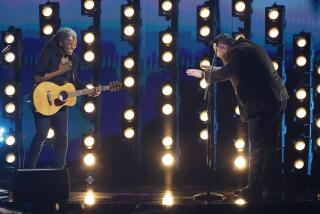Critic’s Choice: Grammys 2015: An archival bounty within best historical album category
As written, the Grammy category of best historical album sounds so stodgy, suggestive of a Ken Burns documentary filled with black-and-white photos panned left to right and a title-line gradually coming into focus.
But rather than conjuring footnoted images of battlefields and marching bands, of cowboys and upright pianos, this year’s five nominees for best historical album recall the Technicolor twang of mid-1960s Los Angeles, travel back to visit some of the most beguiling early recorded music of Southeast Asia and resurrect long-gone radio performances by country music’s supreme whiner.
Here is a rundown of the nominees from which the winner will be announced on Sunday during the daytime Grammy Awards ceremony.
FULL COVERAGE: Grammy Awards 2015
Various artists, “Black Europe: The Sounds and Images of Black People in Europe Pre-1927” (Bear Family) -- What are you doing for the next year? Perhaps exploring “Black Europe,” a 44-CD, 1,200-plus-song, 56-hour, two-hardcover-book package documenting the titular music of an entire population during the first rush of recorded music?
Less a snapshot than a painstakingly detailed mural, “Black Europe” seemingly moves, artist by artist, through every 78 r.p.m. record the archivists could find on the topic at hand. Within this aural encyclopedia, drawn from record labels across Europe, is a ridiculous bounty.
Those curious about the sounds heard at Ciro’s, one of Europe’s first fine-dining chains, can pop on “Yaaka Hula Dickey Dula.” A hot Hawaiian love song on the CD dedicated to the unfortunately named Ciro’s Club Coon Orchestra, it shoots into the present day the sounds of a house band at the London location nearly 100 years ago.
Josephine Baker’s saucy sides are paired on a disc with the Four Harmony Kings gospel vocal group. Three volumes are devoted to sounds of the Paris World Exposition of 1900. Another massive part of the collection features the recordings of Josiah Ransome-Kuti, a patriarch of the same family that generations later gave us Afro-beat legend Fela Kuti.
Wildly informative and quite overwhelming, this collection can hardly be captured in a few scant paragraphs. This is someone’s dissertation.
PHOTOS: Grammys 2015 top nominees
Hank Williams, “The Garden Spot Programs, 1950” (Omnivore) -- Much less imposing, but just as moving, is the collection of recordings that Hank Williams made for a show called “The Garden Spot” in 1950. As documented by the excellent reissue imprint Omnivore, the music the great country and western singer made in a little radio station in southern Iowa lay buried for 64 years. They weren’t even known to exist, according to liner notes writer and music historian Colin Escott.
“The Garden Show 1950” gathers four Williams-featured episodes of the program, sponsored by an Iowa plant nursery and played on KSIB-AM out of Creston, Iowa. Writes Escott, “After buying 15 minutes of airtime on small-market stations, sponsors would pre-record shows with well known artists, duplicate them, and ship them out on 12 or 16-inch transcribed discs.”
As introduced by the program’s host, “the old lovesick drifting cowboy” Williams was in fine form in the winter of 1950 -- even if three years later he’d be dead -- moving through solid, well-rehearsed versions of now-standards including “Lovesick Blues,” “A Mansion on the Hill” and, as Williams introduces it, “a little novelty I wrote” called “Mind Your Own Business.” There’s some down-home banter, quick introductions, a number of renditions of the show’s “Oh! Susanna” closing song and much fiddle, pedal steel and acoustic wonder.
Equally exciting, it’s a beautifully engineered recording seemingly rescued from oblivion. Using the only known copies, 16-inch records with lots of crackle and pop, Grammy-winning mastering engineer Michael Graves (also nominated for “Longing for the Past” -- see below) seems to have resurrected the spirit of Williams himself.
PHOTOS: Guide to the 2015 Grammy Awards
Isham Jones Rainbo Orchestra, “Happy: The 1920 Rainbo Orchestra Sides” (Archeophone) -- Fans of Chicago nightlife will get a buzz to know that dance band leader Isham Jones earned his stripes at the Green Mill in the late 1910s, when it was called Green Mill Gardens. Before one of Al Capone’s guys assumed control of the club in the 1920s, Jones and his small combo were the Gardens’ house band -- until they were lured to the competing Mann’s Rainbo Gardens a few blocks west.
At the new place, Jones and his newly christened Rainbo Orchestra performed brass-based party music described in the fascinating (and Grammy nominated) liner notes as being made in “a musically interesting but uncomfortable period, when American popular dance music had neither the standard instrumentation nor stylistic hallmarks, like those soon to emerge in a few years as main ingredients to the embryonic ‘big band.’” (Decades later that club would be called the Kinetic Playground, where bands including the Jimi Hendrix Experience, Led Zeppelin, the Doors and Rotary Connection performed.)
Those proto-big-band sounds are spread throughout Archeophone’s definitive collection of Jones’ first recordings -- 37 sides made for Brunswick Records. A few years after they were made, Jones would write the melody to one of the great American love songs, “It Had to Be You.” But that’s another story. As an introduction to the sound of Chicago dance music (long before house music), “Happy” opens doors both musically and historically.
Various artists, “There’s a Dream I’ve Been Saving: Lee Hazlewood Industries 1966-1971 (deluxe edition)” (Light in the Attic) -- Lee Hazlewood will forever be known as writer-producer of “These Boots Were Made for Walkin’,” Nancy Sinatra’s megahit that seemed to capture the spirit of go-go era Los Angeles when it was released in 1966. He earned a lot of money with that, and proceeded to build a mini-empire in Los Angeles with the goal of creating more hits and furthering his ascendent career.
It didn’t really happen that way: The fantastical, weirdly beguiling bounty of Hazlewood productions on “There’s A Dream I’ve Been Saving: Lee Hazlewood Industries 1966-1971” sparked a lot of tripped-out misses, the kind that a half-century later sound strangely sublime.
Featuring a lot of Hazlewood’s solo brand of mustachioed-bachelor twang rock, as well as equally mustachioed productions, “Dream” is compiled on four compact discs, a DVD of a film he scored, “Cowboy in Sweden,” and a stunning coffeetable book.
Obsessed with echo since his first recordings of the great Duane Eddy, Hazlewood sounds best when he harnesses that reverb to envelop grand pop structures.
The best of the bunch -- and a song that should have been a hit, is “You Turn My Head Around,” a post-Spector pop masterpiece sung by Ann-Margret and featured on her and Hazlewood’s collaborative album “The Cowboy and the Lady.” A similarly striking range of flower-power era pop-rock can be found throughout “There’s a Dream.”
Various artists, “Longing for the Past: The 78 RPM Era in Southeast Asia” (Dust-to-Digital). To untested Western ears, the sounds that float from “Longing for the Past” seem beamed from some distant imaginary realm. To paraphrase the critic Greil Marcus, the music on this four-CD collection/book captures the old, weird Southeast Asia.
Featuring early and mid-20th century recordings from Burma (now Myanmar), Malaysia, Thailand, Vietnam, Cambodia and other regional islands and countries, “Longing for the Past” explores the myriad music, most of them traditional folk styles, that existed in the region when recording technology arrived in the early 20th century.
The collection’s coproducer, David Murray, writes that the work here represents “a musical era that, to varying degrees, no longer exists. Styles become obsolete, instruments fall into disuse, Western influences seep in, cultures assimilate, and artists fade into obscurity or, as in the horrific case of Cambodia, are wiped out by war or genocide.”
Murray adds that the “old, sometimes obscure sounds” within can certainly be educational, but his aim is more broad, and similar to that of each of the five best historical nominees: to “remind us of the depth and beauty of the past, as we move inexorably forward.”
Read more:
Transcript of Bob Dylan’s MusiCares Person of the Year speech
Photos: Famous artists who haven’t won Grammys
Diversity wins onstage but not in awards arena
Follow Randall Roberts on Twitter: @liledit
More to Read
The biggest entertainment stories
Get our big stories about Hollywood, film, television, music, arts, culture and more right in your inbox as soon as they publish.
You may occasionally receive promotional content from the Los Angeles Times.







